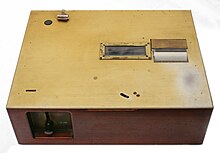கற்பித்தல் இயந்திரம்
கற்பித்தல் இயந்திரங்கள் என்பது ஒரு இயந்திர சாதனம் ஆகும். இவை மாணவர்கள் கல்வி கற்க உதவும் ஒரு பொருள் ஆகும். இதை 1920 களின் மத்தியில் சிட்னி எல். பிரஸ்லீ முதன்முதலில் கண்டுபிடித்தார்.[1] அவரது இயந்திரம் முதலில் பலவுள்தெரிவு விருப்பத் தேர்வுகளை உடைய வினாக்களைக் கொண்டிருந்தது. மாணவர் சரியான பதிலை அளித்தால் மட்டுமே அடுத்த பகுதிக்குச் செல்ல முடியும். கற்றல் எவ்வாறு நடந்தது என்பதைச் சோதனைகள் காட்டுகின்றன.[2][3][4][5] முடிவுகளைப்பற்றிய அறிவு கற்றலை ஏற்படுத்தும் என்பதற்கு இது ஒரு எடுத்துக்காட்டாகும். அதன் பின்னர் நார்மன் கிரவ்டர் பிரஸ்லியின் யோசனைகளை மேலும் விரிவாக்கினார்.

பி.எப்.ஸ்கின்னர் கிளைடர் எனப்படும் இயந்திரத்தை உருவாக்கினார்.[6][7] இது கற்றல் நேர்மறையான வலுவூட்டுதலுடன் எவ்வாறு கையாளப்பட வேண்டும் என்பதை விளக்கப் பயன்பட்டது. ஸ்கின்னர் ஒரு பரந்த அளவிலான பள்ளிமுன்பருவ மற்றும் வயதுவந்த மாணவர்களுக்கான கற்பித்தல் இயந்திரங்களைப் பயன்படுத்துவதை ஊக்கப்படுத்தினார்.[8] வாசிப்பு மற்றும் இசை ஆகியவற்றிலும் இவற்றைப் பயன்படுத்தினார். கற்பித்தல் இயந்திரத்தின் அறிவுத்திறன் திறன் பல காரணிகளிலிருந்து தோற்றுவிக்கப்பட்டது. இது கட்டுப்பாட்டைப் பயன்படுத்தாமல் தானியங்கியாகவும், உடனடியாகவும் மற்றும் வழக்கமான வலுவூட்டல் மூலமும் கற்பித்தலை வழங்கியது. வழங்கப்பட்ட பொருள் ஒத்திசைவு மற்றும் புதுமையான முறையில் இருந்தது. கற்றல் வேகம் ஒவ்வொரு மாணவருக்கும் ஏற்றவாறு பொருத்தமாக சரிசெய்யப்பட்டது. இதன் விளைவாக, மாணவர்கள் ஆர்வமுள்ளவர்களாகவும், கவனமாகவும், விரும்பிய நடத்தை உள்ளவர்களாகவும் "செய்து கற்றல் மூலம்" திறமையானவர்களாகவும் இருந்து கற்றுக் கொண்டனர்.[9][10]
இரண்டு வழிமுறைகளும் நன்றாக இருந்தபோதும், திட்டமிட்டுக் கற்பித்தல் புத்தகங்கள் போன்ற பிற வடிவங்களில் விரிவான அனுபவத்தில் உள்ளன.[11] கற்பித்தல் இயந்திரங்கள் மற்றும் திட்டமிடப்பட்ட கற்றல் பற்றிய கருத்துகள் திறந்தவழிக் கற்றல் மற்றும் கணினிவழிக் கற்பித்தல் ஆகிய கருத்துகளுக்கு அடிப்படையாக அமைந்துள்ளன.[12]
மேற்கோள்கள்
தொகு- ↑ Pressey's priority is supported by Ernest Hilgard in Hilgard E.R. 1966. Learning & the technology of instruction. Chapter 16 in Hilgard E.R. & Bower G.H. 1966. Theories of learning. 3rd ed, New York: Appleton-Century-Crofts, p554 – 561 Programmed learning.
- ↑ Pressey S.L. 1926. A simple apparatus which gives tests and scores – and teaches. School and Society, 23 (586), 373–376.
- ↑ Pressey S.L. 1927. A machine for automatic teaching of drill material. School and Society, 25 (645), 549–552.
- ↑ Pressey S.L. 1932. A third and fourth contribution toward the coming "industrial revolution" in education. School and Society, 36 (934), 668–672.
- ↑ Pressey 1950. Development and appraisal of devices providing immediate automatic scoring of objective tests and concomitant self instruction. Journal of Psychology, 29, 417 – 447.
- ↑ Crowder N. 1959. Automatic tutoring by means of intrinsic programming. In Galanter E.H. (ed) Automatic teaching: the state of the art. New York: Wiley, 109 – 116.
- ↑ Crowder Norman A. 1960. Automatic tutoring by intrinsic programming. In Lumsdaine A.A & Glaser R. (eds) 1960. Teaching machines and programed learning I: a source book. Washington D.C. National Education Association of the United States.
- ↑ Skinner B.F. 1965. The technology of teaching. Appleton-Century-Croft. Includes reprints of all his papers on programmed learning.
- ↑ Skinner B.F. 1961. Teaching machines. Scientific American, 205, 90-112. doi:10.2307/1926170, p. 381
- ↑ Skinner B.F. and Holland J. 1961. The analysis of behavior: a program for self instruction. p.387.
- ↑ Glaser R. (ed) 1965. Teaching machines and programed learning II: data and directions. Washington D.C. National Education Association.
- ↑ Lumsdaine A.A & Glaser R. (eds) 1960. Teaching machines and programed learning I: a source book. Washington D.C. National Education Association of the United States.